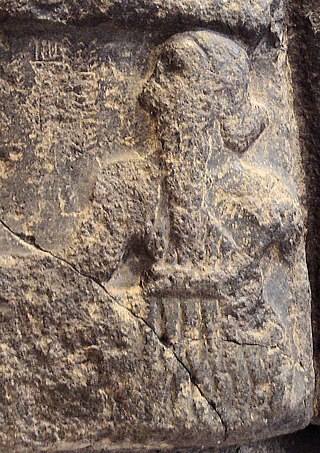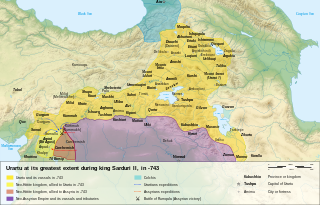In music theory, a diatonic scale is any heptatonic scale that includes five whole steps and two half steps (semitones) in each octave, in which the two half steps are separated from each other by either two or three whole steps, depending on their position in the scale. This pattern ensures that, in a diatonic scale spanning more than one octave, all the half steps are maximally separated from each other.

Akkadian is an extinct East Semitic language that was spoken in ancient Mesopotamia from the third millennium BC until its gradual replacement in common use by Old Aramaic among Assyrians and Babylonians from the 8th century BC.

The Hurrians were a people who inhabited the Ancient Near East during the Bronze Age. They spoke the Hurrian language, and lived throughout northern Syria, upper Mesopotamia and southeastern Anatolia.

The oud is a Middle Eastern short-neck lute-type, pear-shaped, fretless stringed instrument, usually with 11 strings grouped in six courses, but some models have five or seven courses, with 10 or 13 strings respectively.

Cuneiform is a logo-syllabic writing system that was used to write several languages of the Ancient Near East. The script was in active use from the early Bronze Age until the beginning of the Common Era. Cuneiform scripts are marked by and named for the characteristic wedge-shaped impressions which form their signs. Cuneiform is the earliest known writing system and was originally developed to write the Sumerian language of southern Mesopotamia.

Enūma Eliš, meaning "When on High", is a Babylonian creation myth from the late 2nd millennium BCE and the only complete surviving account of ancient near eastern cosmology. It was recovered by English archaeologist Austen Henry Layard in 1849 in the ruined Library of Ashurbanipal at Nineveh. A form of the myth was first published by English Assyriologist George Smith in 1876; active research and further excavations led to near completion of the texts and improved translation.
Urartian or Vannic is an extinct Hurro-Urartian language which was spoken by the inhabitants of the ancient kingdom of Urartu, which was centered on the region around Lake Van and had its capital, Tushpa, near the site of the modern town of Van in the Armenian highlands, now in the Eastern Anatolia region of Turkey. Its past prevalence is unknown. While some believe it was probably dominant around Lake Van and in the areas along the upper Zab valley, others believe it was spoken by a relatively small population who comprised a ruling class.

Assyriology, also known as Cuneiform studies or Ancient Near East studies, is the archaeological, anthropological, historical, and linguistic study of the cultures that used cuneiform writing. The field covers Pre Dynastic Mesopotamia, Sumer, the early Sumero-Akkadian city-states, the Akkadian Empire, Ebla, the Akkadian and Imperial Aramaic speaking states of Assyria, Babylonia and the Sealand Dynasty, the migrant foreign dynasties of southern Mesopotamia, including the Gutians, Amorites, Kassites, Arameans, Suteans and Chaldeans. Assyriology can be included to cover Neolithic pre-Dynastic cultures dating to as far back as 8000 BC, to the Islamic Conquest of the 7th century AD, so the topic is significantly wider than that implied by the root "Assyria".
Siduri, or more accurately Šiduri, is a character in the Epic of Gilgamesh. She is described as an alewife. The oldest preserved version of the composition to contain the episode involving her leaves her nameless, and in the later standard edition compiled by Sîn-lēqi-unninni her name only appears in a single line. She is named Naḫmazulel or Naḫmizulen in the preserved fragments of Hurrian and Hittite translations. It has been proposed that her name in the standard edition is derived from an epithet applied to her by the Hurrian translator, šiduri, "young woman." An alternate proposal instead connects it with the Akkadian personal name Šī-dūrī, "she is my protection." In all versions of the myth in which she appears, she offers advice to the hero, but the exact contents of the passage vary. Possible existence of Biblical and Greek reflections of the Šiduri passage is a subject of scholarly debate.

Music was ubiquitous throughout Mesopotamian history, playing important roles in both religious and secular contexts. Mesopotamia is of particular interest to scholars because evidence from the region—which includes artifacts, artistic depictions, and written records—places it among the earliest well-documented cultures in the history of music. The discovery of a bone wind instrument dating to the 5th millennium BCE provides the earliest evidence of music culture in Mesopotamia; depictions of music and musicians appear in the 4th millennium BCE; and later, in the city of Uruk, the pictograms for ‘harp’ and ‘musician’ are present among the earliest known examples of writing.

Eblaite, or Palaeosyrian, is an extinct East Semitic language used during the 3rd millennium BC in Northern Syria. It was named after the ancient city of Ebla, in modern western Syria. Variants of the language were also spoken in Mari and Nagar. According to Cyrus H. Gordon, although scribes might have spoken it sometimes, Eblaite was probably not spoken much, being rather a written lingua franca with East and West Semitic features.
Andrew R. George is a British Assyriologist and academic best known for his edition and translation of the Epic of Gilgamesh. Andrew George is Professor of Babylonian, Department of the Languages and Cultures of Near and Middle East at the School of Oriental and African Studies, University of London.
In philology, a commentary is a line-by-line or even word-by-word explication usually attached to an edition of a text in the same or an accompanying volume. It may draw on methodologies of close reading and literary criticism, but its primary purpose is to elucidate the language of the text and the specific culture that produced it, both of which may be foreign to the reader. Such a commentary usually takes the form of footnotes, endnotes, or separate text cross-referenced by line, paragraph or page.

Sargon of Akkad, also known as Sargon the Great, was the first ruler of the Akkadian Empire, known for his conquests of the Sumerian city-states in the 24th to 23rd centuries BC. He is sometimes identified as the first person in recorded history to rule over an empire.

Urartu was an Iron Age kingdom centered around Lake Van in the Armenian Highlands. It extended from the eastern bank of the upper Euphrates River to the western shores of Lake Urmia and from the mountains of northern Iraq to the Lesser Caucasus Mountains. Its kings left behind cuneiform inscriptions in the Urartian language, a member of the Hurro-Urartian language family. Since its re-discovery in the 19th century, Urartu, which is commonly believed to have been at least partially Armenian-speaking, has played a significant role in Armenian nationalism.

The Hurrian songs are a collection of music inscribed in cuneiform on clay tablets excavated from the ancient Amorite-Canaanite city of Ugarit, a headland in northern Syria, which date to approximately 1400 BC. One of these tablets, which is nearly complete, contains the Hurrian Hymn to Nikkal, making it the oldest surviving substantially complete work of notated music in the world. While the composers' names of some of the fragmentary pieces are known, h.6 is an anonymous work.

Music archaeology is an interdisciplinary field of study that combines musicology and archaeology. As it includes the study of music from various cultures, it is often considered to be a subfield of ethnomusicology.

Raoul Gregory Vitale was a Syrian musicologist who introduced the total description of the ancient Babylonian musical scales used in Music of Mesopotamia and Near East, and also a complete interpretation of the musical notation of the Hurrian Hymn 6 discovered in Ugarit which is considered to be the first known complete musical notation.

Anne Draffkorn Kilmer was an American historian of the ancient Near East who served as a professor of Assyriology at the University of California, Berkeley. She was an expert in ancient Mesopotamian culture, specifically Sumero-Akkadian cuneiform texts and the history of ancient music, games, and mathematics. In 1963, she became the first woman appointed to a tenure-track position in what is now the Middle Eastern Languages and Cultures department at the University of California, Berkeley. She later became curator of the Babylonian collection in the Phoebe A. Hearst Museum of Anthropology, formerly the Lowie Museum. She rose to the rank of Professor, served as chair of her department three times, and acted as dean of humanities.













